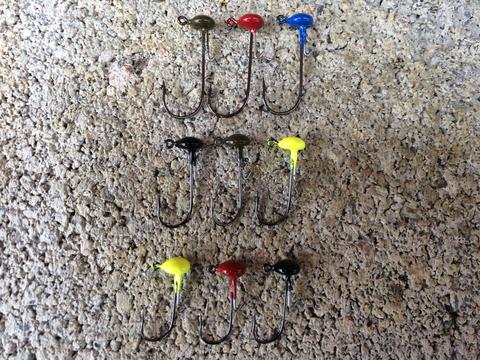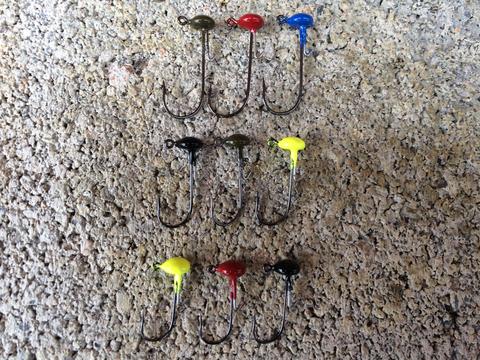For years on end, a 1/32-ounce mushroom-style jig with either a No. 4 or a No. 6 hook has played a critical role in the repertoire of Midwest finesse anglers. It is especially effective when they ply shallow-water lairs that are adorned with laydowns, flooded terrestrial vegetation, piles of rocks and boulders, riprap, man-made brush piles, aquatic vegetation, and other kinds of objects that litter our waterways.
What’s more, it facilitates our incessant quest to employ a no-feel retrieve.
To our dismay, however, we lost our primary source of 1/32-ounce mushroom-style jigs in 2017. And since then, Travis Myers of Paw Paw, West Virginia, has been working with Robert Shue to create a state-of-the-art mushroom-style jig that weighs 1/32 an ounce and possesses a No. 6, No. 4, or No. 2 hook. It is called the 1/32-ounce Tactical Finesse Jig.
Myers is an occasional contributor to the Finesse News Network and In-Fisherman’s Midwest Finesse column, reporting about how, when, where, and why he plies the streams in West Virginia for smallmouth bass with Midwest finesse tactics.
Shue is the proprietor of River Rock Custom Baits in Waynesboro, Virginia. And during the winter of 2016-17, he converted Travis Myers into becoming a River Rock disciple.
And nowadays Myers and Shue converse almost daily about how, when, and where to use Midwest finesse tactics to catch the smallmouth bass that abide in the rivers and streams that crisscross the Appalachian Mountain region and nearby environs.
As their friendship developed, Shue began manufacturing a 1/16-ounce mushroom-style jig, which he calls a Tactical Finesse Jig. Then in February of 2018, Shue began manufacturing the 1/32-ounce Tactical Finesse Jig, which he calls an ultra-finesse jig. As of now, they are a special-order item. Therefore, he makes them only when an angler orders them, and he suspects that most orders can be made and shipped in two to three weeks.

Shue reported in an email that the diameter of the head is about .250 inches or a quarter of an inch. Its circumference is about .785 inches or slightly more than three-quarters of an inch. The head is about .093 inches or three-thirty-seconds of an inch thick.
Each jig is built around an Eagle Claw 570 black-platinum hook, which are corrosion resistant. It is available in three hook sizes: No. 2, No. 4, and No. 6. From the bend of the hook to the face of the jig, the No. 2 hook is fifteen-sixteenths of an inch long. The No. 4 hook is thirteen-sixteenths of an inch long. The No. 6 hook is eleven-sixteenths of an inch long. Myers notes that the hooks on most finesse jigs are too long. And he has found that a long hook prevents a soft-plastic bait from undulating and quivering alluringly. But Myers says that is not the case with the River Rock’s 1/32-ounce Tactical Finesse Jig that Shue has created.
The gap between the point and shank of the No. 2 hook is three-eighths of an inch. The gap between the point and shank of the No. 4 hook is five-sixteenths of an inch. The gap between the point and shank of the No. 6 hook is nine-thirty-seconds of an an inch. Midwest finesse anglers work with an exposed hook, and an exposed hook with a smaller gap is relatively snag-free. The small gap, however, does not impede these thin-wire hooks from readily penetrating the flesh in the mouth of a black bass.
A wire bait keeper radiates from the back of the head and is positioned parallel to the shank of the hook. The bait keeper is five-sixteenths of an inch long.
They are available in black, blue, green-pumpkin-black, red, and yellow. A package of 10 costs $7.00.
On Feb. 14, 15, and 16, we exchanged a series of emails with Myers about how he uses the 1/32-ounce Tactical Finesse Jig.
Here is an edited and condensed version of his emails:
Straightaway, Myers said that the 1/32-ounce Tactical Finesse Jig is the only jig that he uses, and he uses all three hook sizes. It is, in fact, the first jig that he has not had to modify before he affixes it to a soft-plastic bait and fishes with it. “Simply put,” he said, “they are my perfect jig and one that has been in my head for a lot of years hoping that someone would offer it.”
If he is dissecting sections of a stream that are embellished with flooded trees, laydowns, and ranks of boulders, Myers will use the jig with the hook that has the least amount of gap…





